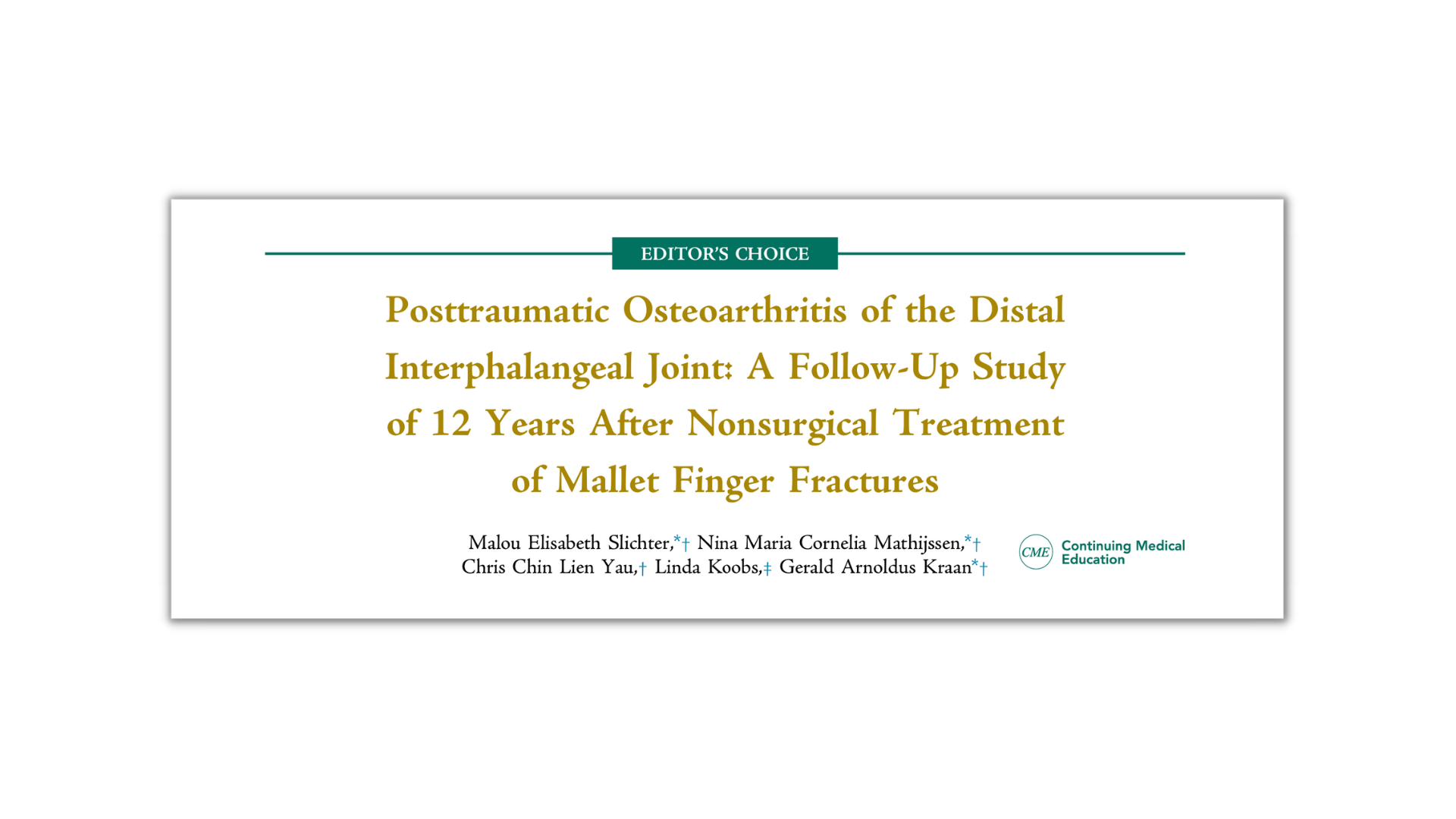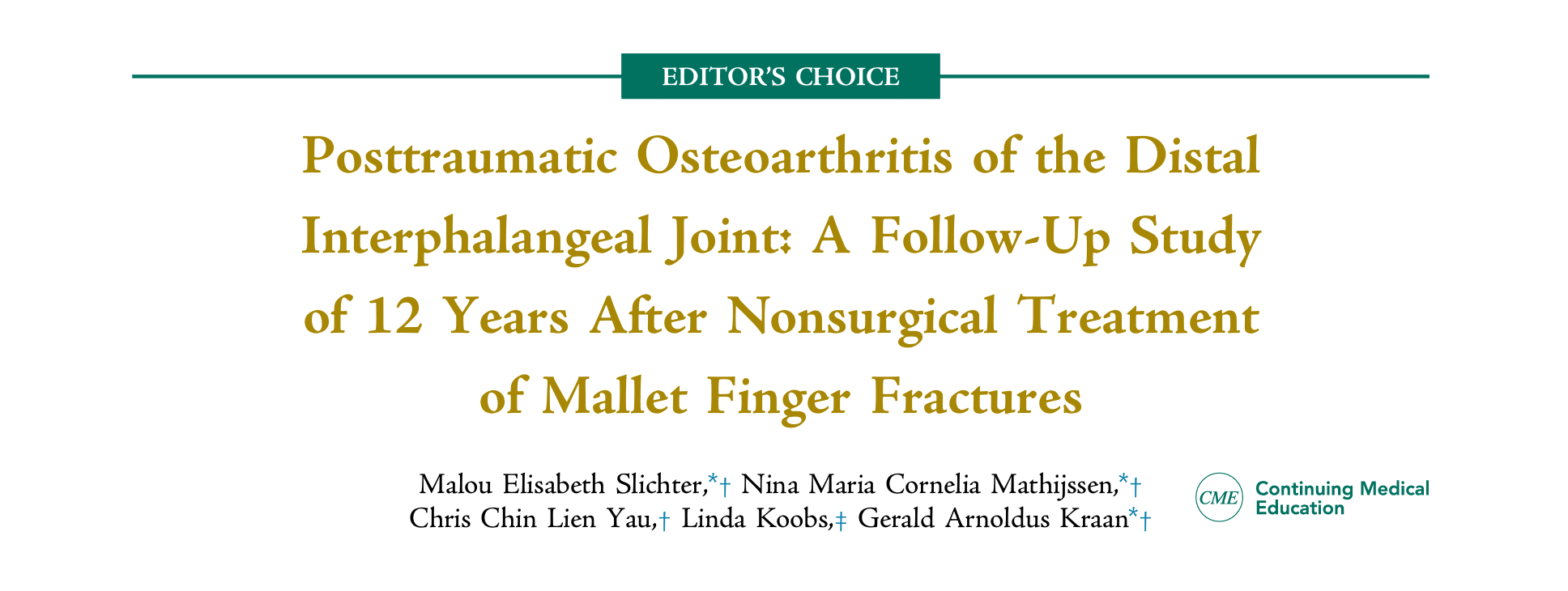
In this Journal Club
- Summary
Independent fresh perspective that differs from the authors. - Deep-Dive
3 Key Points
3 Limitations
3 ways to improve your clinical practice
3 recommended readings - Powerpoint Slides
Coming soon!
Summary
An independent fresh perspective that can differ from the authors' abstract summary.

Level of Evidence: Retrospective cohort study
Background:
Treat mallet finger fractures (MFF) to minimize extension lag, reduce subluxation, and restore DIP joint congruency. This should prevent secondary osteoarthritis (OA).
Aim
Evaluate OA, functional outcomes, and PROMS after MFF.
Methods
Assessed radiographic osteoarthritis (OA), range of motion, pinch strength, and PROMs. The patient's healthy contralateral DIPJ was used as the control.
Results
A cohort of 52 MFF patients (mean duration: 12.1 years). ~40% had OA, with ~25% showing more severe OA than healthy joint. Slight reduction in outcomes & PROMS, which were moderately correlated with radiographic OA.
Conclusions
MFF-related radiological OA resembles natural joint degeneration in the DIP joint. It leads to reduced DIP joint range of motion but does not clinically impact PROMs.
Deep Dive
An anlaysis to identify key findings, limitations, clinical practice improvements, and additional reading.
Key Points
· Learning: Treatments, long-term stiffness and osteoarthritis
· Limitations: Retrospective, bias, small size, and confounders
· Clinical practice: Education, OA strategies, judicious surgery
· Further reading: Systematic Reviews, Q-DASH, Natural History.
3 Learning Points
Treatment & Complications of Mallet Fractures
The "Background" and "Discussion" sections of this article provide a solid foundation into the treatment options and complications of mallet finger injuries.
- The non-operative treatment uses an extension splint on the Distal Interphalangeal (DIP) joint for 24/7 usage over 6-8 weeks. This approach suits acute soft tissue injuries, minimally displaced bony mallet injuries without joint subluxation.
- Operative treatments like Closed Reduction Percutaneous Pinning (CRPP) and Open Reduction Internal Fixation (ORIF) are necessary for cases like volar subluxation of the distal phalanx or when more than 50% of the articular surface is involved or the articular gap is over 2mm.
The treatment goal for mallet finger fractures (MFFs) is to ensure healing in a near anatomical position to reduce extension lag, subluxation, and restore DIP joint congruency. Undertreatment risks chronic issues like secondary osteoarthritis, flexion deformity, and persistent DIP joint stiffness.
Long Term Outcomes from Non-Operative Management
From this study, the are a few important points and facts that can be drawn from the results
- Patients will likely develop a stiffer finger than a non-injured finger
- There will be greater degree of OA on the injured finger.
- Non-union is unlikely.
- Radiological findings do not strongly correlate to clinical findings.
How to write a "proper" abstract
The structuring of the abstract could be improved, as the Results section appears to intrude upon the Methods section. The sentence, "At follow-up, there was an increase in OA in 41% to 44% of the MFFs" should be properly placed in the Results section as it describes the outcomes of the study, not the methodologies employed.
The conclusion drawn in the study would benefit from more explicit phrasing and definitive assertions. The statement, "Radiological OA after an MFF is similar to the natural degenerative process in the DIP joint" needs to be explained more clearly for better understanding of the findings. Instead of using vague comparisons, it would be more beneficial to state the impact of the results and their significance in the field.
3 Limitations
1. Retrospective design introduces potential inaccuracies and bias.
2. Radiographic disparities, small sample size, and low power skews results.
3. Long-term follow-up and uncontrolled variables adds confounders.
Study Design
- Retrospective Nature: As a retrospective cohort study, it relies on past data and patient records, which might contain errors or omissions. The retrospective nature doesn't allow for control of variables or interventions during the course of the study, potentially affecting the validity of the results. As the authors state: "no radiograph of the healthy control digit at time of injury was obtained; thus, we do not know the true progression of degenerative changes in the healthy control DIP joint".
- Selection Bias: Patients were selected based on diagnosis treatment codes, potentially not representing the full affected population. The exclusion of certain groups (those who can't communicate in Dutch or English, those with contralateral or multiple MFFs) can limit the generalizability of the results.
- Partial Blinding: Despite some blinding, it might not be entirely possible to blind the patients or the clinicians to the patient's injury status, which could introduce bias.
Outcome Assessment and Analysis
- Radiographic Interpretation: Radiographic assessments were conducted by two independent raters, which may have led to differences in interpretation. Even though consensus was reached, disagreements might have impacted the results' validity.
- Sample Size: The small sample size of 52 patients might limit the study's power to detect significant differences and affect the results' generalizability. The authors states: "Since this is a retrospective cohort study, we aimed for as many inclusions as possible; therefore, we did not perform a sample size analysis".
- Post Hoc Power Analysis: The post hoc power analysis revealed an inadequate power for the KL and OARSI classifications, indicating a high risk of type II errors (failing to detect a difference where one exists), which impacts the reliability of the study findings. As the authors state: "Post hoc power analyses showed inadequate power, meaning that only a descriptive analysis was possible".
Potential Confounders
- Long Follow-Up Period: The lengthy follow-up period of 10-15 years might introduce additional variables like changes in a patient's health status, lifestyle, or treatments, which could affect the results.
- Uncontrolled Variables: The study didn't account for other factors like smoking, diet, other diseases, and physical activities. These could affect the progression of OA, introducing confounding variables.
3 Ways to Improve Your Clinical Practice
1. Improved patient education
2. Proactive managment of OA.
3. Consideration of Surgical Intervention .
Improved Patient Education
We could improve our practice by providing comprehensive patient education about the potential risks and outcomes of Mallet Finger Fractures (MFFs). This includes the likelihood of developing osteoarthritis (OA), the potential for a decrease in range of motion (ROM), and possible aesthetic changes to the hand. By informing patients of these risks prior to treatment, they can have realistic expectations about their recovery and potential long-term outcomes.
Proactive Management of Osteoarthritis
Given the observed increase in OA after MFF, surgeons should consider proactive strategies to manage and potentially delay the onset of OA. This could include exercises to maintain joint flexibility, medications, or lifestyle advice to slow the progression of OA. Additionally, more frequent follow-ups might be needed to monitor OA progression in MFF patients.
Consideration of Surgical Intervention
While all patients in this study were treated non-surgically, the results indicate that some patients (29%) had complaints post-treatment and two required arthrodesis due to persistent deformity. Surgeons might consider surgical interventions in some cases of MFF, especially in patients with severe fractures or those who prioritize hand aesthetics. Careful patient selection for surgical intervention, possibly taking into account factors like patient's activity level, profession, or personal preferences, might lead to better overall outcomes.
3 Further Recommended Readings






